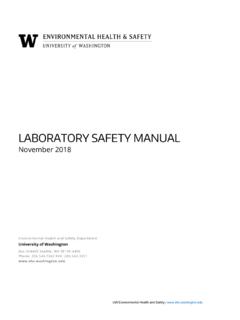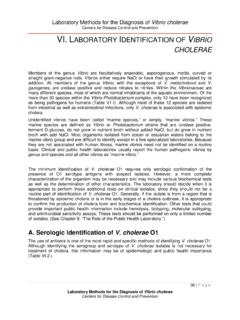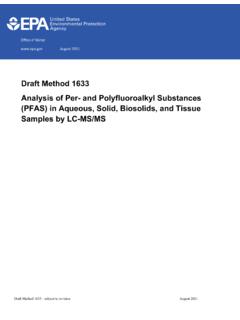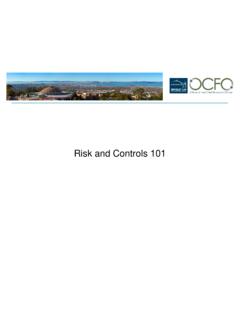Transcription of Guidelines for Environmental Infection Control in Health ...
1 Accessable version: Guidelines for Environmental Infection Control in Health -Care Facilities Recommendations of CDC and the Healthcare Infection Control Practices Advisory Committee (HICPAC). Department of Health and Human Services Centers for Disease Control and Prevention (CDC). Atlanta, GA 30329. 2003. Updated: July 2019. Ebola Virus Disease Update [August 2014]: The recommendations in this guideline for Ebola has been superseded by these CDC documents: Infection Prevention and Control Recommendations for Hospitalized Patients with Known or Suspected Ebola Virus Disease in Hospitals ( us/ ). Interim Guidance for Environmental Infection Control in Hospitals for Ebola Virus ( ). See CDC's Ebola Virus Disease website ( ) for current information on how Ebola virus is transmitted. New Categorization Scheme for Recommendations [November 2018]. In November 2018, HICPAC voted to approve an updated recommendation scheme. The category Recommendation means that we are confident that the benefits of the recommended approach clearly exceed the harms (or, in the case of a negative recommendation, that the harms clearly exceed the benefits).
2 In general, Recommendations should be supported by high- to moderate-quality evidence. In some circumstances, however, Recommendations may be made based on lesser evidence or even expert opinion when high-quality evidence is impossible to obtain and the anticipated benefits strongly outweigh the harms or when then Recommendation is required by federal law. For more information, see November 2018 HICPAC Meeting Minutes [PDF - 126. pages] ( ). C. difficile Update [April 2019]: Recommendations and and the supporting text were updated to reflect changes in Federal regulatory approvals: LIST K: EPA's Registered Antimicrobial Products Effective against Clostridium difficile Spores ( against-clostridium). Interim Measles Infection Control [July 2019]. See Interim Infection Prevention and Control Recommendations for Measles in Healthcare Settings ( ). 1 of 241. Guidelines for Environmental Infection Control in Health -Care Facilities (2003). Suggested Citations: Available from the CDC Internet Site: The full-text version of the Guidelines appears as a web-based document at the CDC's Division of Healthcare Quality Promotion's Infection Control website ( ).
3 The full-text version of the Guidelines should be cited when reference is made primarily to material in Parts I and IV. The print version of the Guidelines appears as: Sehulster LM, Chinn RYW, Arduino MJ, Carpenter J, Donlan R, Ashford D, Besser R, Fields B, McNeil MM, Whitney C, Wong S, Juranek D, Cleveland J. Guidelines for Environmental Infection Control in Health -care facilities. Recommendations from CDC and the Healthcare Infection Control Practices Advisory Committee (HICPAC). Chicago IL; American Society for Healthcare Engineering/American Hospital Association; 2004. Part II of these Guidelines appeared in the CDC's Morbidity and Mortality Weekly Report: . Centers for Disease Control and Prevention. Guidelines for Environmental Infection Control in Health -care facilities: recommendations of CDC and the Healthcare Infection Control Practices Advisory Committee (HICPAC). MMWR 2003; 52 (No. RR-10): 1 48. Updates to the Part II recommendations also appeared in the MMWR in 2003 as Errata: Vol.
4 52 (No. RR-10) (MMWR Vol. 52 [42]: 1025 6) on October 24, 2003 and as a Notice to Readers scheduled to appear in February 2004. The full-text version of these Guidelines (this document) incorporates these updates. Last update: July 2019 2 of 241. Guidelines for Environmental Infection Control in Health -Care Facilities (2003). Centers for Disease Control and Prevention Healthcare Infection Control Practices Advisory Committee (HICPAC). Guidelines for Environmental Infection Control in Health -Care Facilities Abstract Background: Although the environment serves as a reservoir for a variety of microorganisms, it is rarely implicated in disease transmission except in the immunocompromised population. Inadvertent exposures to Environmental opportunistic pathogens ( , Aspergillus spp. and Legionella spp.) or airborne pathogens ( , Mycobacterium tuberculosis and varicella-zoster virus) may result in infections with significant morbidity and/or mortality. Lack of adherence to established standards and guidance ( , water quality in dialysis, proper ventilation for specialized care areas such as operating rooms, and proper use of disinfectants) can result in adverse patient outcomes in Health -care facilities.
5 Objective: The objective is to develop an Environmental Infection - Control guideline that reviews and reaffirms strategies for the prevention of environmentally-mediated infections, particularly among Health -care workers and immunocompromised patients. The recommendations are evidence-based whenever possible. Search Strategies: The contributors to this guideline reviewed predominantly English-language articles identified from MEDLINE literature searches, bibliographies from published articles, and Infection - Control textbooks. Criteria for Selecting Citations and Studies for This Review: Articles dealing with outbreaks of Infection due to Environmental opportunistic microorganisms and epidemiological- or laboratory experimental studies were reviewed. Current editions of Guidelines and standards from organizations ( , American Institute of Architects [AIA], Association for the Advancement of Medical Instrumentation [AAMI], and American Society of Heating, Refrigeration, and Air-Conditioning Engineers [ASHRAE]) were consulted.
6 Relevant regulations from federal agencies ( , Food and Drug Administration [FDA]; Department of Labor, Occupational Safety and Health Administration [OSHA]; Environmental Protection Agency [EPA]; and Department of Justice). were reviewed. Some topics did not have well-designed, prospective studies nor reports of outbreak investigations. Expert opinions and experience were consulted in these instances. Types of Studies: Reports of outbreak investigations, epidemiological assessment of outbreak investigations with Control strategies, and in vitro Environmental studies were assessed. Many of the recommendations are derived from empiric engineering concepts and reflect industry standards. A few of the Infection - Control measures proposed cannot be rigorously studied for ethical or logistical reasons. Last update: July 2019 3 of 241. Guidelines for Environmental Infection Control in Health -Care Facilities (2003). Outcome Measures: Infections caused by the microorganisms described in this guideline are rare events, and the effect of these recommendations on Infection rates in a facility may not be readily measurable.
7 Therefore, the following steps to measure performance are suggested to evaluate these recommendations: 1. Document whether Infection - Control personnel are actively involved in all phases of a healthcare facility's demolition, construction, and renovation. Activities should include performing a risk assessment of the necessary types of construction barriers, and daily monitoring and documenting of the presence of negative airflow within the construction zone or renovation area. 2. Monitor and document daily the negative airflow in airborne Infection isolation rooms (AII) and positive airflow in protective environment rooms (PE), especially when patients are in these rooms. 3. Perform assays at least once a month by using standard quantitative methods for endotoxin in water used to reprocess hemodialyzers, and for heterotrophic, mesophilic bacteria in water used to prepare dialysate and for hemodialyzer reprocessing. 4. Evaluate possible Environmental sources ( , water, laboratory solutions, or reagents) of specimen contamination when nontuberculous mycobacteria (NTM) of unlikely clinical importance are isolated from clinical cultures.
8 If Environmental contamination is found, eliminate the probable mechanisms. 5. Document policies to identify and respond to water damage. Such policies should result in either repair and drying of wet structural materials within 72 hours, or removal of the wet material if drying is unlikely within 72 hours. Main Results: Infection - Control strategies and engineering controls, when consistently implemented, are effective in preventing opportunistic, environmentally-related infections in immunocompromised populations. Adherence to proper use of disinfectants, proper maintenance of medical equipment that uses water ( , automated endoscope reprocessors and hydrotherapy equipment), water-quality standards for hemodialysis, and proper ventilation standards for specialized care environments ( , airborne Infection isolation [AII], protective environment [PE], and operating rooms [ORs]), and prompt management of water intrusion into facility structural elements will minimize Health -care associated Infection risks and reduce the frequency of pseudo-outbreaks.
9 Routine Environmental sampling is not advised except in the few situations where sampling is directed by epidemiologic principles and results can be applied directly to Infection Control decisions, and for water quality determinations in hemodialysis. Reviewers' Conclusions: Continued compliance with existing Environmental Infection Control measures will decrease the risk of Health -care associated infections among patients, especially the immunocompromised, and Health -care workers. Last update: July 2019 4 of 241. Guidelines for Environmental Infection Control in Health -Care Facilities (2003). Centers for Disease Control and Prevention Healthcare Infection Control Practices Advisory Committee (HICPAC). Guidelines for Environmental Infection Control in Health -Care Facilities Table of Contents List of Abbreviations Used in This Publication .. 9. Executive Summary .. 15. Part I. Background Information: Environmental Infection Control in Health -Care 17. A. Introduction .. 17. B. Key Terms Used in this Guideline.
10 19. C. Air .. 20. 1. Modes of Transmission of Airborne Diseases .. 20. 2. Airborne Infectious Diseases in Health -Care Facilities .. 21. 3. Heating, Ventilation, and Air Conditioning Systems in Health -Care Facilities .. 27. 4. Construction, Renovation, Remediation, Repair, and 35. 5. Environmental Infection - Control Measures for Special Health -Care Settings .. 48. 6. Other Aerosol Hazards in Health -Care 54. D. Water .. 54. 1. Modes of Transmission of Waterborne Diseases .. 54. 2. Waterborne Infectious Diseases in Health -Care 55. 3. Water Systems in Health -Care Facilities .. 60. 4. Strategies for Controlling Waterborne Microbial 68. 5. Cooling Towers and Evaporative Condensers .. 72. 6. Dialysis Water Quality and Dialysate .. 74. 7. Ice Machines and 80. 8. Hydrotherapy Tanks and Pools .. 82. 9. Miscellaneous Medical/Dental Equipment Connected to Main Water 84. E. Environmental Services .. 86. 1. Principles of Cleaning and Disinfecting Environmental Surfaces .. 86. 2. General Cleaning Strategies for Patient-Care Areas.














